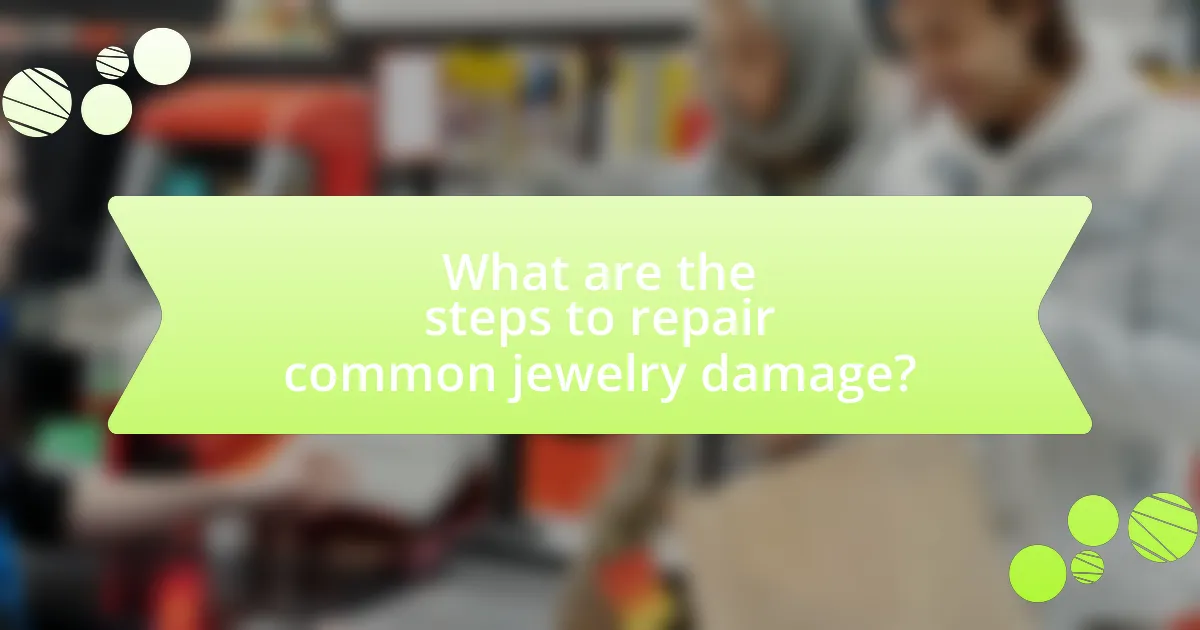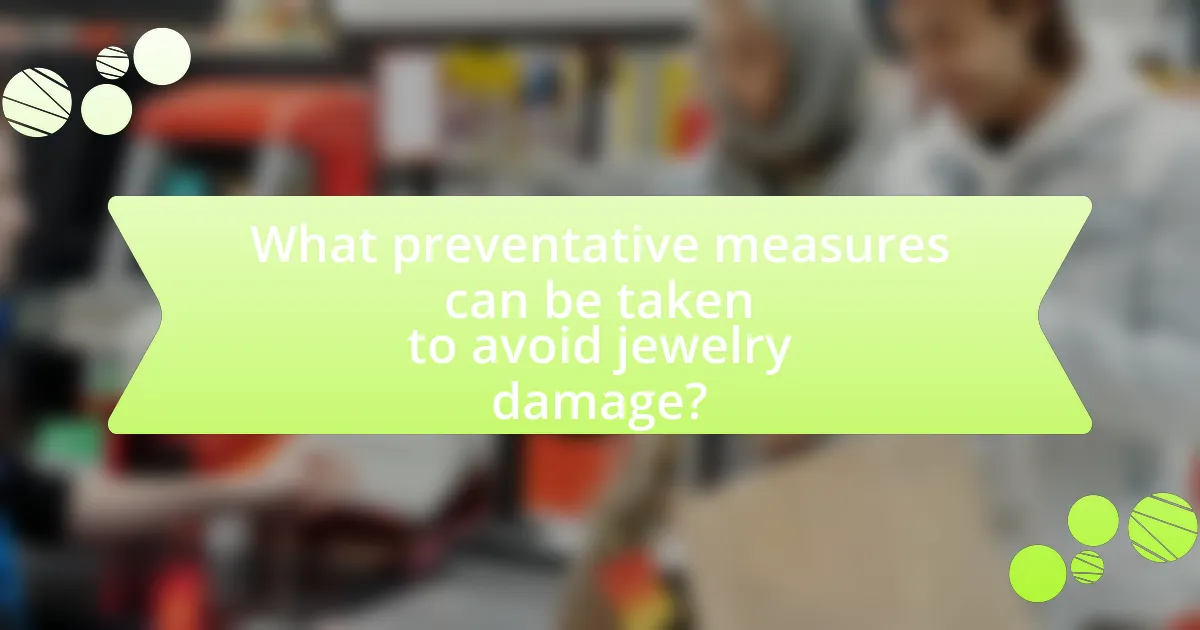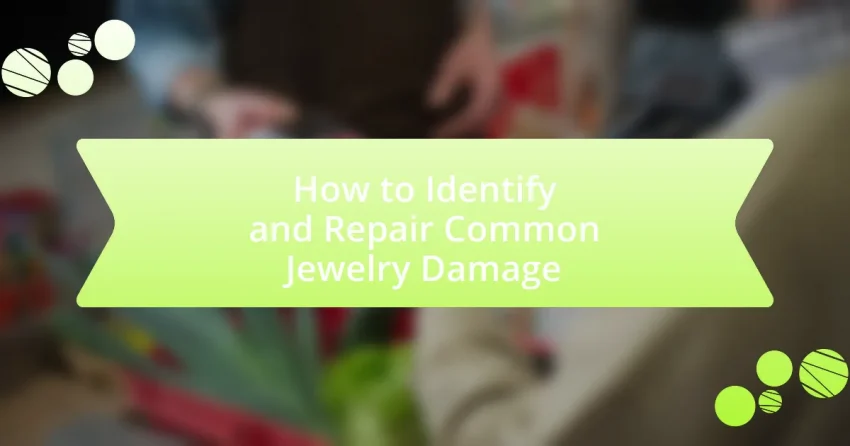The article focuses on identifying and repairing common types of jewelry damage, including scratches, loose stones, broken clasps, and tarnishing. It provides detailed methods for detecting scratches using tools like magnifying glasses and jewelers’ loupes, as well as steps to assess and secure loose gemstones. Additionally, the article outlines effective repair techniques for clasps and chains, emphasizes the importance of proper storage and maintenance to prevent damage, and offers practical tips for cleaning and inspecting jewelry. Overall, it serves as a comprehensive guide for maintaining the integrity and appearance of jewelry.

What are the common types of jewelry damage?
Common types of jewelry damage include scratches, dents, broken clasps, loose stones, and tarnishing. Scratches occur on the surface of metals and gemstones due to contact with hard surfaces, while dents can happen from impacts. Broken clasps compromise the security of the jewelry, making it prone to loss. Loose stones can result from wear and tear or improper settings, leading to potential loss of the gemstone. Tarnishing affects metals like silver and gold, causing discoloration due to exposure to air and moisture. These types of damage are frequently encountered in everyday wear and require appropriate repair methods to restore the jewelry’s condition.
How can you identify scratches on jewelry?
To identify scratches on jewelry, examine the surface under good lighting and use a magnifying glass for closer inspection. Scratches typically appear as fine lines or marks on the metal or gemstone surfaces, contrasting with the surrounding area. The presence of scratches can be confirmed by running a fingernail or a soft cloth over the surface; if you feel a rough texture or see light reflecting differently, it indicates a scratch. Additionally, using a jeweler’s loupe can help in detecting scratches that are not visible to the naked eye, as it magnifies the surface details significantly.
What tools can help in detecting scratches on different materials?
Tools that can help in detecting scratches on different materials include magnifying glasses, jewelers’ loupes, and optical microscopes. Magnifying glasses provide a basic level of magnification to identify surface imperfections, while jewelers’ loupes offer higher magnification and are specifically designed for examining fine details in jewelry. Optical microscopes allow for even greater magnification and can reveal scratches that are not visible to the naked eye, making them essential for thorough inspections. These tools are widely used in the jewelry industry to ensure the quality and integrity of materials.
How do scratches affect the overall appearance of jewelry?
Scratches significantly diminish the overall appearance of jewelry by creating visible imperfections on the surface. These imperfections disrupt the reflective quality of the metal or gemstone, leading to a less polished and dull look. For instance, a study published in the Journal of Materials Science found that even minor scratches can reduce the luster of precious metals by up to 30%, impacting the jewelry’s aesthetic appeal. Additionally, scratches can accumulate dirt and oils, further detracting from the jewelry’s visual charm.
What signs indicate a loose gemstone?
Signs that indicate a loose gemstone include noticeable movement of the stone within its setting, gaps between the gemstone and the metal, and the presence of scratches or wear around the setting. When a gemstone shifts easily or can be wiggled with minimal pressure, it suggests that the prongs or bezel holding it are compromised. Additionally, if light can be seen through gaps, this further confirms that the gemstone is not securely set. Regular inspection of these signs is essential for maintaining the integrity of jewelry and preventing loss.
How can you check if a gemstone is secure in its setting?
To check if a gemstone is secure in its setting, gently press the gemstone with your fingertip to see if it moves or wobbles. A securely set gemstone should not shift or feel loose when pressure is applied. Additionally, inspect the prongs or bezel holding the gemstone; they should be intact and not bent or broken. If the prongs are worn down or the bezel is damaged, the gemstone may not be secure. Regular checks can prevent loss or damage, as loose stones can easily fall out during wear.
What are the potential risks of a loose gemstone?
Loose gemstones pose several potential risks, including loss, damage to the gemstone or setting, and injury to the wearer. When a gemstone is not securely set, it can easily fall out, leading to permanent loss. Additionally, a loose gemstone may shift during wear, causing scratches or chips to the stone itself or damaging the surrounding metal setting. This instability can also result in sharp edges that may cause injury to the wearer or others. According to the Gemological Institute of America, proper setting is crucial to prevent these risks, emphasizing that secure mounting is essential for both the longevity of the gemstone and the safety of the wearer.
How can you recognize broken clasps or chains?
You can recognize broken clasps or chains by inspecting them for visible gaps, misalignment, or inability to securely fasten. A broken clasp may not close properly or may feel loose, while a broken chain often shows a separation between links or a complete break. Additionally, if the clasp or chain feels unusually light or has a rough texture, it may indicate damage. Regular checks for these signs can help maintain jewelry integrity.
What are the common causes of clasp and chain damage?
Common causes of clasp and chain damage include wear and tear from regular use, exposure to harsh chemicals, and improper storage. Regular use can lead to metal fatigue, causing clasps to weaken or chains to break. Exposure to chemicals such as perfumes, lotions, and cleaning agents can corrode metal components, compromising their integrity. Additionally, improper storage, such as tangling with other jewelry or being subjected to excessive pressure, can lead to physical damage. These factors collectively contribute to the deterioration of clasps and chains in jewelry.
How does broken jewelry impact its functionality?
Broken jewelry significantly impairs its functionality by rendering it unusable for its intended purpose, such as wearing or displaying. For instance, a broken clasp prevents a necklace from being secured around the neck, while a cracked gemstone diminishes the aesthetic appeal and structural integrity of the piece. This loss of functionality can lead to further damage if not addressed, as sharp edges may cause injury or additional wear to the jewelry. Repairing broken jewelry restores its functionality, allowing it to serve its original purpose effectively.

What are the steps to repair common jewelry damage?
To repair common jewelry damage, follow these steps: first, assess the type of damage, such as broken clasps, loose stones, or tarnished metal. Next, gather necessary tools like pliers, a soft cloth, and adhesive if needed. For broken clasps, use pliers to reattach or replace the clasp. For loose stones, apply a small amount of jewelry adhesive to secure the stone back in place. To remove tarnish, gently polish the metal with a soft cloth or a specialized jewelry cleaner. Each of these steps addresses specific types of damage, ensuring effective repair and restoration of the jewelry’s appearance and functionality.
How can you fix scratches on jewelry?
To fix scratches on jewelry, you can use a polishing cloth or a jewelry polishing compound specifically designed for the type of metal. For example, a microfiber cloth can effectively buff out minor scratches on gold or silver jewelry. Additionally, using a fine polishing compound, such as a jeweler’s rouge, can help restore the shine and minimize the appearance of deeper scratches. This method is supported by the fact that polishing compounds are commonly used in the jewelry industry to maintain the finish of various metals.
What methods are effective for polishing out scratches?
Effective methods for polishing out scratches include using a polishing cloth, applying a metal polish, and utilizing a fine abrasive compound. Polishing cloths, often treated with compounds, can gently buff out minor scratches on jewelry surfaces. Metal polishes, specifically designed for various materials like silver or gold, can restore shine while minimizing the appearance of scratches. Fine abrasive compounds, such as those used in jewelry polishing machines, can effectively smooth out deeper scratches when applied carefully. These methods are validated by their widespread use in jewelry care, demonstrating their effectiveness in maintaining the appearance of jewelry.
When should you seek professional help for scratch repair?
You should seek professional help for scratch repair when the scratches are deep, extensive, or affect the structural integrity of the jewelry. Professional jewelers possess specialized tools and expertise to restore the item without causing further damage. For instance, if a scratch penetrates the metal or gemstone, it may require polishing or even replacement of the affected part, which is best handled by a professional. Additionally, if the jewelry holds significant monetary or sentimental value, professional repair ensures that the piece is treated with the care it deserves.
What should you do if a gemstone is loose?
If a gemstone is loose, you should take it to a professional jeweler for repair. Loose gemstones can lead to loss or further damage if not addressed promptly. Professional jewelers have the tools and expertise to securely re-set the gemstone, ensuring it is properly fitted in its setting. This action is crucial because a loose gemstone increases the risk of it falling out, which is a common issue in jewelry maintenance.
How can you safely re-secure a loose gemstone?
To safely re-secure a loose gemstone, first, assess the setting to determine if it can be tightened or if a repair is necessary. If the setting is adjustable, gently use pliers to squeeze the prongs or bezel to hold the gemstone firmly in place. If the setting is damaged or the gemstone is significantly loose, consider taking the jewelry to a professional jeweler for proper re-setting. Professional jewelers have the tools and expertise to ensure the gemstone is securely fastened without risking damage to the stone or the setting.
When is it necessary to replace a gemstone setting?
It is necessary to replace a gemstone setting when it is damaged, loose, or no longer secure, which can lead to the loss of the gemstone. A damaged setting may exhibit visible cracks, bent prongs, or signs of wear that compromise its integrity. Additionally, if a gemstone frequently shifts or falls out, it indicates that the setting is inadequate and requires replacement to ensure the gemstone’s safety. Regular inspections by a professional jeweler can help identify these issues early, preventing potential loss.
How can you repair broken clasps or chains?
To repair broken clasps or chains, you can use pliers to reattach or replace the broken components. For a broken clasp, open the jump ring with pliers, attach it to the clasp and chain, and then close the ring securely. If the chain is broken, locate the ends, use pliers to open a jump ring, connect the ends, and close the ring tightly. This method is effective as it utilizes basic jewelry repair techniques that are widely recognized and practiced by jewelers.
What tools are needed for clasp and chain repairs?
To repair clasps and chains, essential tools include pliers, wire cutters, and jump ring openers. Pliers are necessary for gripping and manipulating small components, while wire cutters are used to trim excess wire or chain links. Jump ring openers facilitate the opening and closing of jump rings, which are often integral to clasp and chain connections. These tools are standard in jewelry repair, ensuring precision and effectiveness in restoring functionality to damaged pieces.
How can you determine if a clasp or chain is beyond repair?
A clasp or chain is beyond repair if it exhibits severe structural damage, such as significant breaks, corrosion, or missing components that cannot be replaced. Specifically, if the metal is cracked or the clasp mechanism is completely non-functional, it indicates irreparability. Additionally, if the chain links are extensively worn down or have lost their shape, they may not hold together securely, rendering them unusable. These conditions are often irreversible, as they compromise the integrity and safety of the jewelry.

What preventative measures can be taken to avoid jewelry damage?
To avoid jewelry damage, proper care and storage are essential. Regularly cleaning jewelry with a soft cloth prevents tarnishing and buildup of dirt, while storing pieces separately in a soft-lined box or pouch minimizes scratches and tangling. Additionally, removing jewelry before engaging in activities such as exercising, swimming, or applying lotions protects it from exposure to harsh chemicals and physical stress. According to the Jewelers of America, these practices can significantly extend the lifespan of jewelry, ensuring it remains in optimal condition.
How can proper storage prevent jewelry damage?
Proper storage prevents jewelry damage by minimizing exposure to environmental factors and physical abrasion. Storing jewelry in a cool, dry place reduces the risk of tarnishing and corrosion caused by humidity and temperature fluctuations. Additionally, using individual compartments or soft pouches prevents pieces from scratching each other, which is a common cause of damage. For example, storing silver jewelry in anti-tarnish cloth can significantly slow down the tarnishing process, as these materials are designed to absorb moisture and prevent oxidation.
What are the best practices for storing different types of jewelry?
The best practices for storing different types of jewelry include using individual compartments for each piece, keeping jewelry in a cool, dry place, and avoiding exposure to sunlight. Individual compartments prevent scratches and tangling, which is particularly important for delicate items like necklaces and earrings. Storing jewelry in a cool, dry environment helps prevent tarnishing and damage, especially for silver and gold pieces. Additionally, avoiding direct sunlight protects gemstones from fading and losing their luster. These practices are supported by recommendations from jewelry care experts, who emphasize the importance of proper storage to maintain the integrity and appearance of jewelry over time.
How does environmental exposure affect jewelry longevity?
Environmental exposure significantly reduces jewelry longevity by causing corrosion, tarnishing, and degradation of materials. Factors such as humidity, temperature fluctuations, and exposure to chemicals can accelerate these processes. For instance, silver jewelry tarnishes when exposed to sulfur compounds in the air, while gold can suffer from scratches and dullness due to abrasive particles in the environment. Additionally, exposure to chlorine in swimming pools can weaken the structural integrity of certain metals, leading to potential breakage. Studies indicate that jewelry stored in controlled environments, away from moisture and chemicals, maintains its appearance and durability longer than those exposed to harsh conditions.
What maintenance routines can help preserve jewelry condition?
Regular cleaning, proper storage, and periodic inspections are essential maintenance routines that help preserve jewelry condition. Cleaning jewelry with a soft cloth after each wear removes oils and dirt, preventing buildup that can dull its shine. Storing jewelry in a dry, separate compartment or a soft pouch minimizes scratches and tangling, protecting delicate pieces. Additionally, inspecting jewelry every few months for loose stones or signs of wear allows for timely repairs, which can prevent further damage. These practices are supported by industry standards, which emphasize that proper care can extend the lifespan of jewelry significantly.
How often should jewelry be cleaned and inspected?
Jewelry should be cleaned and inspected at least every six months. Regular cleaning helps maintain its appearance and prevents buildup of dirt and oils, while inspections allow for early detection of any damage or loose stones. According to the American Gem Society, routine maintenance is essential for preserving the integrity and longevity of jewelry pieces.
What cleaning methods are safe for various jewelry materials?
Safe cleaning methods for various jewelry materials include using mild soap and water for gold and silver, a soft cloth for pearls, and a specialized cleaner for gemstones. Gold and silver can be cleaned effectively by mixing a few drops of mild dish soap with warm water, soaking the jewelry briefly, and gently scrubbing with a soft brush. Pearls require a gentle approach; wiping them with a damp cloth after wearing helps maintain their luster, while avoiding harsh chemicals. For gemstones, using a cleaner specifically designed for the type of stone ensures safety, as some stones can be sensitive to certain chemicals. These methods are validated by jewelers who recommend gentle cleaning to preserve the integrity and appearance of the jewelry.
What are some practical tips for identifying and repairing jewelry damage?
To identify and repair jewelry damage, first examine the piece for visible signs such as scratches, loose stones, or broken clasps. Use a magnifying glass to inspect intricate details and check for any discoloration or wear on the metal. For repairs, clean the jewelry with a gentle solution to remove dirt, then tighten any loose components using appropriate tools. If stones are loose, consider using a jeweler’s adhesive or seek professional help for resetting. Regular maintenance, such as polishing and checking for wear, can prevent further damage.
